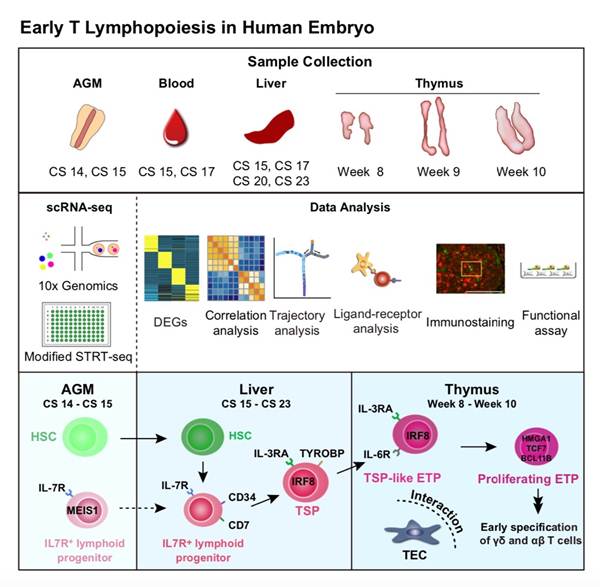Major progress has been made in the origin of human T lymphocytes and thymus organogenesis as a result of a joint research project among Professor Hongbo Hu’s research team of State Key Laboratory of Biotherapy, Bin Liu’s team at the Fifth Medical Center of the General Hospital of the People’s Liberation Army, and Yu Lan’s team of School of Medicine, Ji’nan University. The research findings have been published under the title of “Single-cell RNA Sequencing Resolves Spatiotemporal Development of Pre-thymic Lymphoid Progenitors and Thymus Organogenesis in Human Embryos” in the top-notch journal of Immunity( IF=21.561 ).


Figure 1: Graphical Abstract
The researchers first aim at the cells in the thymus organogenesis stage ( 8-10 weeks ) of human embryo, and then use high-throughput single cell transcriptome sequencing to identify four major cell groups, including hematopoiesis, epithelium, stroma and endothelium. They further divide the hematopoiesis cells into 10 subgroups ( Figure 2 ), namely: three ETP subgroups, three T-cell precursor subgroups, and subpopulations of inherent lymphocyte, macrophage, dendritic cell and mast cell, etc. By comparing the differentially expressed genes of embryonic ETP ( mainly from 8 weeks ) and fetal ETP (mainly from 9 and 10 weeks), it is concluded that hematopoietic progenitor cells may migrate into thymus in different ways before and after the formation of intrathymic blood vessels ( 8 weeks ). In addition to T cell potential, CD7 + ETP (lin-cd45 + CD34 + cd1a-cd7 +) still has the multi lineage differentiation potential of myeloid, B and NK, which is different from the differentiation potential of adult CD7 + ETP with only T and NK.

Figure 2: Hematopoietic cell population and characteristic genes in human fetal thymus
In addition, through the combined analysis of thymus ETP and lymphoid progenitor cells in different development stages, hematopoiesis sites and circulating blood, it was found that ETP was most similar to lymphoid progenitor cells in fetal liver at similar development stages. It is further divided into two subgroups: the more similar one has more resting cell cycle ( TSP like ETP ), while the other one is in a more active cell cycle ( promoting ETP ). The part of lymphoid progenitor cells that overlaps with TSP like ETP in the development track is defined as TSP. Previous studies have shown that in the embryonic development stage earlier than thymus organogenesis; thus, the authors have further realized the population capture and molecular characteristics analysis of lymphoid progenitor cells in the aortogonad mesonephron region as early as 5 weeks at the transcriptome level. In addition, the author has analyzed the different gene regulation patterns of d and b T lymphocytes in the thymus of human embryo, explaining the early differentiation events of thymic epithelial cell ( TEC ). This study has, for the first time in the world, constructed the molecular map of early human embryonic T-lymphocyte development and thymus organogenesis by single cell transcriptome sequencing.
Article link: https://www.cell.com/immunity/fulltext/S1074-7613(19)30404-2
